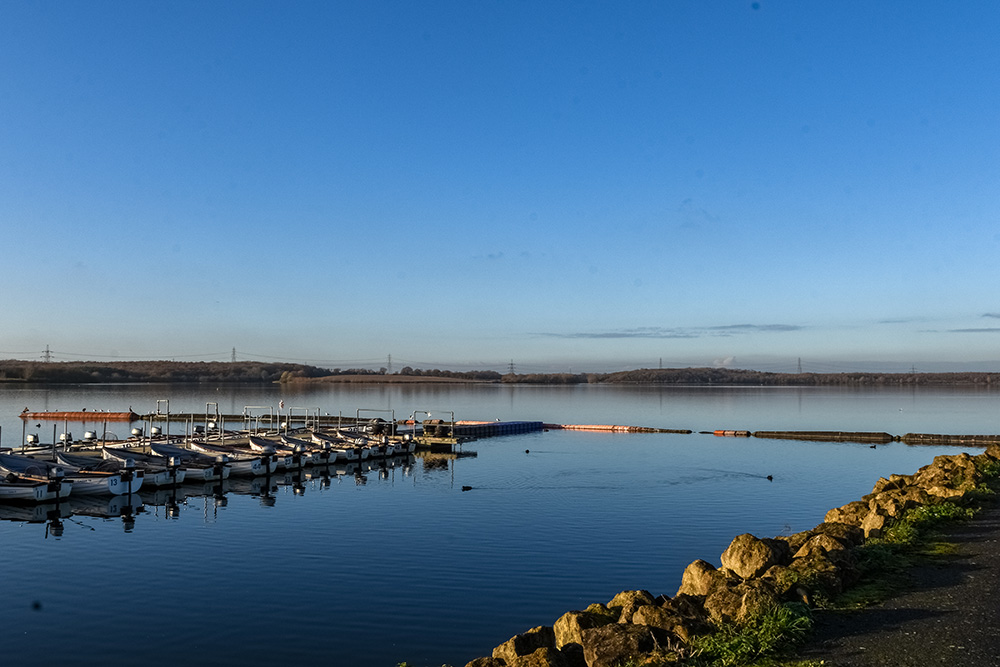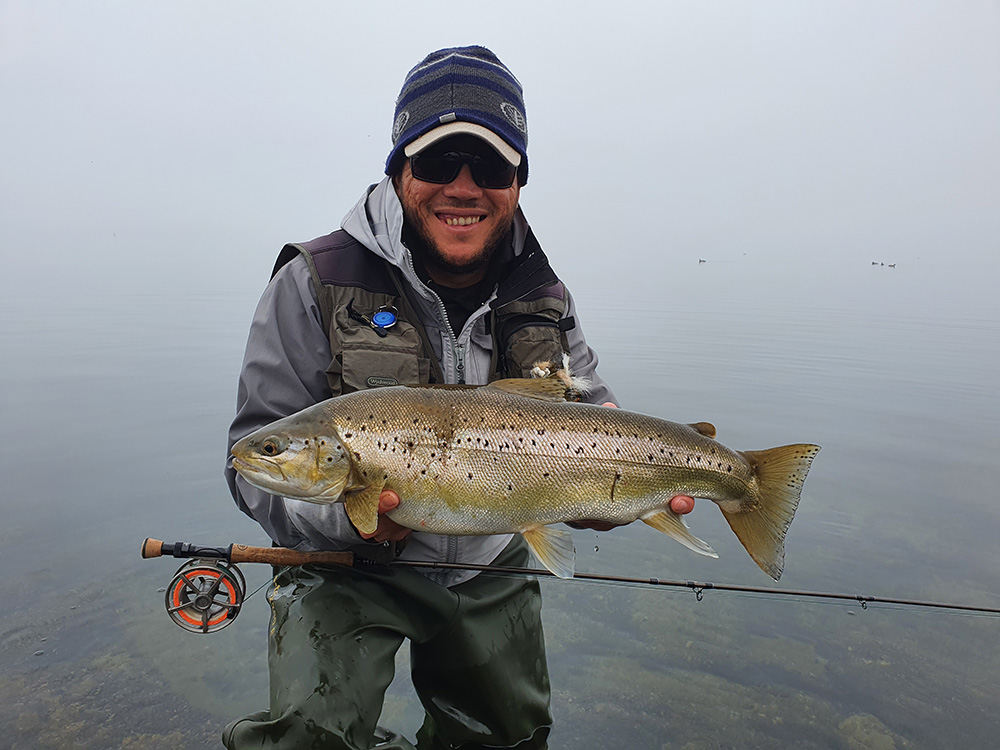By Thomas Finney
The arrival of the first frosts sees much of the invertebrate life that the trout prey on in our reservoirs start to die off, in turn the trout now turn their attention to the abundant shoals of coarse fish fry found in many of our waters and this creates a spectacular feeding frenzy and some of the most exciting fly fishing of the season. The sight of both rainbow and brown trout herding the fry together and striking into them in coordinated attacks is enough to excite any angler, however for such aggressive feeding fish they are not always the easiest fish to tempt. With patience and persistence these fish are catchable, here is a guide to my approach at targeting these fry feeders.

Setting up
Rods
For the most part when targeting fry feeding trout you will be using large flies, for this reason I would recommend at least a 7 weight fly rod to do the job although lighter rods can be used on calmer days for fishing smaller patterns such as floating fry. My personal favourite rod for this type of fishing is the Wychwood RS2, this rod allows me to make long casts with large flies, is very forgiving in the top half to help reduce line breakages and has plenty of power in the lower section to turn and land large fish. I normally carry 2 setups, a 10 foot 7 weight and a 10 foot 8 weight that allows me to fish a wide range of methods on different lines.
Reels
When targeting fry feeders, I like to have the option of changing lines to follow the fish through different levels of the water column. For this reason, I always use a cassette type reel to enable me to make a quick line change without the need to change my reel, rod or leader. My reel of choice for this would be the Wychwood Truefly SLA MKII, this reel is super light weight and comes with multiple spools that can be changed in a matter of minutes which really is a great help when you need a quick change to take advantage of a feeding spell.
Fly Lines
The amount of fly lines carried can depend largely on the spot or venue you are fishing. If you are fishing over shallow weed beds for example you would probably only be able to fish a floating line where’s if you are fishing off a jetty giving access to deep water you could fish anything from a floating line to a fast sinker. As a general rule wherever I go I always make sure I have a floating line, an intermediate line and at least one fast sinking line on me.
Leader Material
At this time of year, the fish are very aggressive, hard fighting and often quite large so your leader material has to be up to the job. For this type of fishing I would recommend a leader of at least 8 lb breaking strain. I personally prefer fishing 10 or even 12 lb, the last thing you want is to finally hook a large fish only to be broken off due to fishing too light a leader. For fishing subsurface flies, I generally fish fluorocarbon straight through, I really like Wychwood Ghost Mode fluorocarbon for this as it is strong yet super supple and it has excellent knot strength. When I am fishing a surface pattern such as a floating fry I normally opt for a multipolymer leader with a short length of fluorocarbon tippet which allows most of my leader to sit high in the water and the last couple of feet of fluorocarbon before the fly to sink and avoid being too visible to the fish, for this leader I use Wychwood Silk Mode Multipolymer connected to about 3 feet of Ghost mode fluorocarbon via a four turn water knot.
Fly Selection
It goes without saying that fishing for these fish requires the use of fry imitations. The size of your fly used should be matched to the size of baitfish that the trout are feeding on, at this time of year one to three inches is the typical size. My favourite fry patterns include floating fry, minkies, snakes, minky boobies, deer hair fry and humungous (both the weighted and booby versions). It pays to have a selection of colours as well to cope with different light levels and water clarity. White, black, light brown, grey, olive and pink are all good colours at this time of the year.

Techniques
There are several different techniques and methods that I use to catch these fish, below are my favourite.
· Floating fry – This is a great method to use in shallow water, over weed beds and in any situation where fish are likely to take off the surface. Floating fry patterns can be fished with a variety of retrieves but I find the most effective to be casting it out, giving it a few pops and then twitching it back with a lot of pauses. These patterns can also be effective fished static like a dry fly as well as being stripped across the surface at speed.
· Floating line – Another tried and tested method is fishing a single fly such as a minky or humungous on a floating line with a long leader. The best retrieve for fishing this method is a slow figure of eight retrieve with a few strips in between. This method is particularly effective when fish can be seen chasing fry on the surface as well as fishing around calmer areas such as harbours.
· Pulling – Pulling lures is familiar to most stillwater fly anglers and this method defiantly has its place when targeting fry feeders. A range of lines can be used from floating lines to intermediates to fast sinkers and it can be effective with any fry pattern you choose to fish. The key to success with this method is to play around with different retrieves to see what the fish want, some days the fish will want the fly ripped back and other times a figure of eight retrieve with a few long pulls here and there is needed. When fishing this method takes will often come as the flies drop through the water and especially on the hang at the end of the retrieve so make sure you are ready for this.
· Buoyant flies off the deck – This has got to be one of the most effective ways of catching large fry feeding trout and some of my biggest fish have fallen to this method. This method involves fishing a fast sinking line with one or two buoyant flies such as a booby or a deer hair fry, the leader length depends on how far above the bottom you want your flies to be fishing. The key to this method cast out and pull your line tight and allow your line time to sink, once at you desired depth start a very slow figure of 8 retrieve, this method keeps your flies in the strike zone and takes can come at any point in the retrieve.

Location
Small fish fry are never far away from some form of cover or shelter and if there are fry in an area, the trout won’t be too far away. Weed beds, points, rocky areas, drop offs and bays are always good areas to try as are man made structures such as boat harbours, jetties, pontoons, valve towers and dam walls. The key is to keep watching the water for signs of activity and keep on the move until you find fish, birds working the water is always a good sign that there are fry about. Feeding spells are often short often lasting 5 to 10 minutes so I will often visit good fish holding areas a few times in a day. It pays to start early at this time of the year as there is often a lot of activity in the mornings, last light is also a good time to be out so don’t go home too early.
Overall fry feeders present an exciting challenge, they are not the easiest fish to catch and you will rarely catch large numbers of fish but this is a time of year when many personal bests are broken so get out there and chase some this winter!


